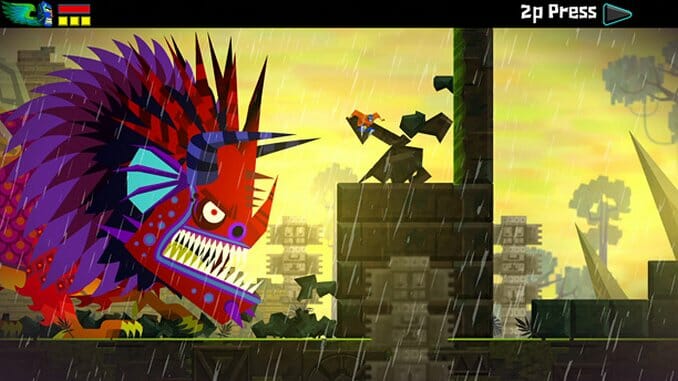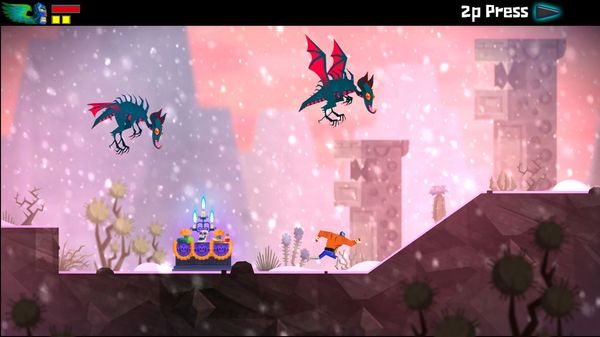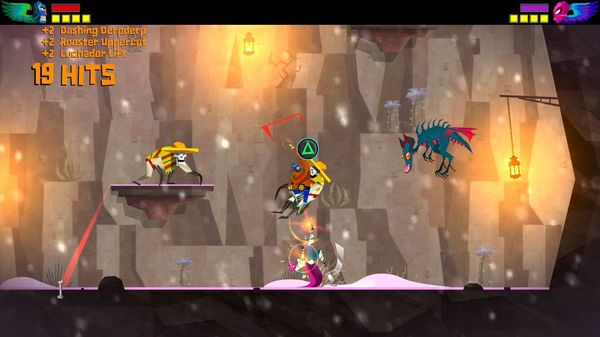Guacamelee (PS3/Vita)

Ask any slash fiction writer, or the people who make that cake-flavored vodka: Combining two great things is risky business. Guacamelee is a similar roll of the dice from Drinkbox Games, who seek to unite the wonderful worlds of Metroidvania play and lucha libre/Mexican folklore aesthetics. The game’s story concerns Juan, a lowly agave farmer in a city that seems to do very little besides drinking tequila and worshiping lucha libre wrestlers (understandable). His love interest (El Presidente’s daughter, of course) gets kidnapped by a demonic charro skeleton intending to make her his skeleton bride while uniting the world of the dead and the world of the living. Juan is eventually granted a magical lucha libre mask that allows him to travel from world to world (and that also removes his shirt) and sets off on his quest for love.
The world-switching is one of Guacamelee’s centerpieces. Some platforms are only usable in the world of the dead, and some are only usable in the world of the living. Some enemies can only be damaged in one or the other (throwing an enemy and quickly switching worlds so it collides properly with another enemy never gets old), and so on. Mechanics aside, it’s satisfying that almost every inch of Guacamelee has a light-world and dark-world version—the world of the dead swaps out the game’s usual vibrant reds, greens, and oranges for muted blues and greys. Basically everything in the world of the dead that can be a skeleton is a skeleton. It’s great.
True to its Metroid heritage, Guacamelee places a strong emphasis on platforming. Juan’s jumps feel good enough, but many of the game’s most clever sequences involve such deft manipulation of midair dashes and special moves that it felt almost like a momentum-driven endless-running game. (In a classy concession to the player, a fall will merely deposit Juan on the last solid ground he was standing on.) Even during Guacamelee’s most difficult areas, there’s roughly a 1:1 correlation between the amount of time I spend on an enraging platforming room and the amount of progress I got out of it. Each such room creates a neat thought process along the lines of “What in God’s name am I supposed to do here” / “Oh. That’s insane.” / “Oh. It’s not so bad.” Rare is the platformer that is this successful at taking the kid gloves off but not coming across as an unfair time sink.
When Juan is not falling off cliffs so often that I have a light bruise on my thigh from hitting it out of frustration, the bulk of Guacamelee’s action revolves around beating people up. The beatings fit pretty squarely in a combo-based beat-‘em-up mold, albeit with an emphasis on hurling foes into other foes that brings Mischief Makers to mind (How often does that happen?). The fights control extremely tightly, and, as Juan’s wrestling repertoire increases, the combat system reveals a surprising and under-utilized depth. Fighting isn’t given the same shake as jumping in the game’s occasionally controller-hurlingly-difficult optional sequences, and Guacamelee’s boss fights—while undoubtedly some of the game’s high points—end up being Punch-Out-style tests of pattern recognition rather than the combo crucibles the game seems to set you up for. The fight controls in Guacamelee are proficient enough that I would pay for an all-fighting competitive multiplayer DLC—Drinkbox sells it short by neglecting to really test the player’s mettle.
Much of Guacamelee’s success stems from the immense amount of care that went into its art direction. Its locations are beautiful, its colors are striking, and its animation practically sets a new standard for the current wave of 2-D games. The flashing neon title cards that appear onscreen before boss fights and after acquiring new items are so cool-looking that they’re practically worth the price of admission on their own. If the crux of a Metroidvania adventure is its ability to cajole the player into exploring the entire map, Guacamelee would likely pass the test even without the time-honored allure of Getting Everything. (Which is nice, considering most of Guacamelee’s secrets take the form of money that’s doled out so liberally it becomes useless for the final 25% of the game.)

